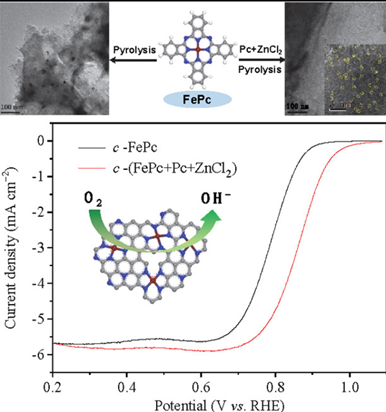The development of high-performance nonprecious metal catalysts (NPMCs) to supersede Pt-based catalysts for the oxygen reduction reaction (ORR) in polymer electrolyte membrane fuel cells is highly desirable but remains challenging. In this paper, we present a pyrolysis strategy for spatial confinement and active-site fixation using iron phthalocyanine (FePc), phthalocyanine (Pc) and Zn salts as precursors. In the obtained carbon-based NPMC with a hierarchically porous nanostructure of thin-layered carbon nanosheets, nearly 100% of the total Fe species are FeII-N4 active sites. In contrast, pyrolyzing FePc alone forms Fe-based nanoparticles embedded in amorphous carbon with only 5.9% FeII-N4 active sites. Both experimental characterization and density functional theory calculations reveal that spatial confinement through the staggered π–π stacking of Pc macrocycles effectively prevents the demetallation of Fe atoms and the formation of Fe-based nanoparticles via aggregation. Furthermore, Zn-induced microporous defects allow the fixation of FeII-N4 active sites. The synergistic effect of staggered stacking confinement and microporous defect fixation results in a high density of atomic FeII-N4 active sites that can enhance the ORR. The optimal FeII-N4-C electrocatalyst outperforms a commercial Pt/C catalyst in terms of half-wave potential, methanol tolerance, and long-term stability in alkaline media. This modulation strategy can greatly advance efforts to develop high-performance NPMCs.
https://doi.org/10.1016/S1872-2067(21)63992-X
